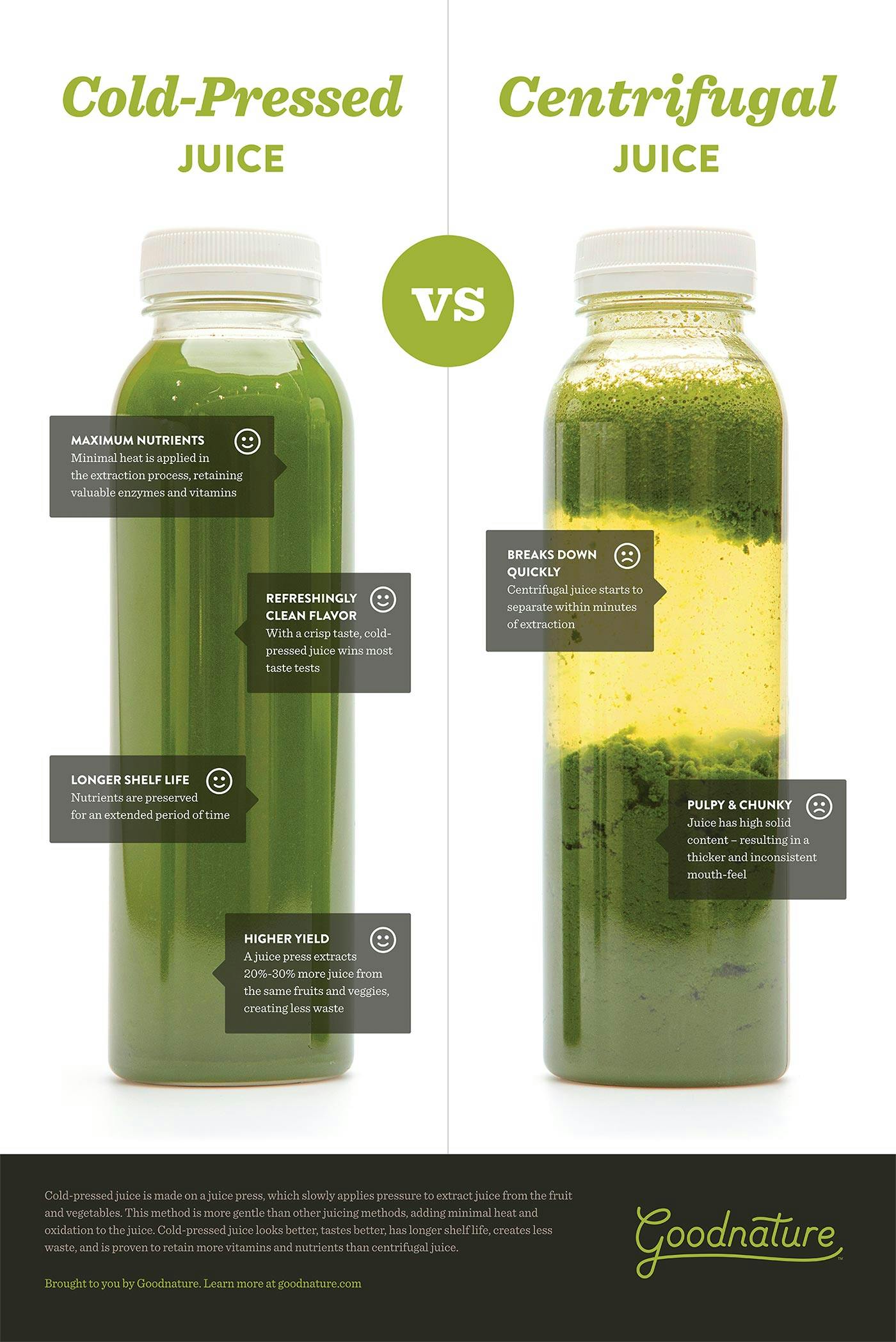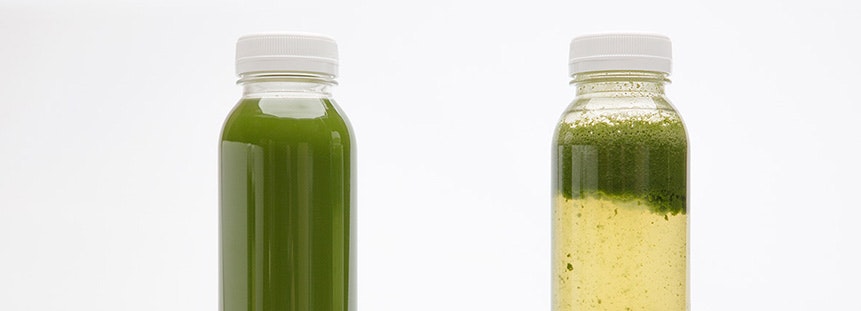Lots of people debate whether or not there really are differences between juice made using a press and juice made in a centrifugal juicer.
Last year, we had the two types of juice analyzed by a certified food lab and published the results. The results showed that the nutrients in centrifugal juice break down much faster than they do in cold-pressed juice.
Note: This How to Write a Juice Business Plan PDF is a step-by-step guide to helping you write a business plan for your juice business. Download it for free!

Truthfully, we don’t need lab tests to show us there’s a difference in how quickly the juice breaks down. You can actually see it, even within the first hour:
Details:
- Both bottles used the same recipe: Kale, cucumber, celery, lemon, ginger, green apple
- Both bottles used 1.5 lbs of produce
- Both bottles were processed at the same time
- The centrifugal juice was made using a Nutrifaster N450
- The cold-pressed juice was made using a Goodnature CT7

Important: By “cold press” we mean an actual juice press, NOT a “slow juicer”, which will give results more similar to a centrifugal juicer.
The obvious visual difference is how the juice is separated. This is believed to be caused by heat and oxidation, which is high in centrifugal juice because of how the juice is extracted. The produce is chopped up and flung into a fast spinning screen, which forces the juice out by centrifugal force. Compare that to the cold-press process, in which the produce is chopped up, then gently but firmly squeezed by a press like a nice massage. Happy juice comes from happy fruit. (See also: What is Cold Pressed Juice?)
In our constant and shameless effort to educate the world about the benefits of cold-pressed juice, we have made available this infographic. If you wish to display this in your juice bar, restaurant, or grocery store, you may purchase posters, table tents, or postcards in our online store.
You can learn more about how juicers work here. Or, browse loads of amazing, chef-made juicing recipes here.
Note: Whether you’re starting a juice bar, a juice delivery service, or a wholesale juice business, this How to Write a Juice Business Plan guide explores the key elements of a successful juice business plan, along with industry tips, resources, and downloadable content to help you write it. Get it for free!

Comments
I am really interested to start a business to provide healthy juices. could you provide any guidance on that also recommend me a good juicer
Hi! Here is a link to our blog article that lists 20+ must read articles for starting your juice business.
https://www.goodnature.com/blog/20-must-read-articles-if-youre-starting-a-juice-business
Additionally, we offer free 30 minute consultations with our juice consultants who are a great resource for figuring out the first steps, picking a juicer, and more.
Just sign up through the following link: https://www.goodnature.com/consulting-request
Good Morning, Can you recommend a Juicer, I have been researching Cold Press Juicers and my brain hurts!
Hi Kristen, absolutely! 🙂 Lora will email you shortly.
I want to start juice business
Hi Muhammad,
That's great! Someone from our team will email you to see how we can help, thank you!
Hi,
Press can be used to extract juice from Wet Dates?.
The only experience I've had with this is when we are making almond milk, and putting some soaked dates into the mixture. It works well on that, however I've never pressed dates alone without nuts. If you would like us to do some testing for you, please use the contact page and it will be routed to the correct person. Thank you!
WE really loved your content here about RAW JUICE. In South FLorida we LOVE cold press
check us out www.rawjuicedelivered.com
When I tested a couple different centrifugal juicers, the rotary blade is warmer after a juice session than the X1 plate. This may be because the centrifugal juicer is on constantly compared to the X1, but I'm sure the RPM/friction also creates more heat.
Using the X1, I also find that I can fill a 16oz bottle or more with 1.5 lbs of produce and about 2 lbs if the recipe contains carrots. The claims by blueprint of 6 lbs of produce/bottle (if true) literally means that they are wasting a ton of produce. I've also seen 3-5 lbs advertised by another local juice company, which is ridiculous.
In regards to the first point, I also believe that a lot of the heat from a centrifugal juicer is a result of the motor being so close to the rotary blade. In the X1, the blade is extended far from the motor. This allows for the motor to get warm without transferring the heat to the blade of the grinder.
And to the second point, I couldn't agree with you more! There are many brands who claim anywhere from 5 lbs even all the way up to 7 lbs of produce in every bottle, when it only takes 1.5 - 2.0 lbs of produce to make a 16 oz juice. I don't understand where their numbers are coming from.
Hello,
Do you have further information regarding the nutrient concentration. There is not a lot of datas available, and it would be really interesting to compare the vitamins & minerals concentration between cold press and centrifugal juicer.
A trustable french magazine (Que Choisir) did some analysis and showed that the concentration of vitamin C was higher in a cold press juice : 100% vs 79%, but at the opposite the amount of vitamin K, B9, carotenoids is lower in a cold press juice.
I would like to know if you have done some trials, or perhaps plan to do some, it would be really useful.
Thanks,
Dominique
Hi !
Can your presses be used to produce oils ? Such as olive oil, nuts & seed oils ?
If so, do olives have to be pitted or crushed first ?
Here, in SE Asia, a lot of vendors are using hydraulic presses, in the local markets, to press coconuts, normally 'cream', the 'head', from the first press, and 'milk', the 'tail', from a second press. Oil can then be separated out, and the pulp dried and ground to flour etc....
You have any experience in this ?
Cheers, Chris
Yes, a press can be used to make nut oil, olive oil, and seed oil.
although written well, the entire article is not based on anything scientific or remotely logical.
i have vast experience in juicing with all of these machines and i understand exactly what is going on with the various results.
first lets dispel the myth that rotary machines heat juice. they do not heat juice any more or less than the rotary shredder on a norwalk machine, an x-series machine, or other when used in the home on small runs of juice. If you start with a carrot solid with a surface temp. of 42 degrees and rotary juice it, the juice temp is usually 50 degrees. The same exact result is yielded from all other type of cold press juicers.
That being said, all of the machines use a rotary blade that is subject to friction and therefore after long continual use as in a commercial setting can begin to heat the juice to cooking temperatures.
If older type cold press machines are used for hours on end with out cooling the machines, your pulp can be cooked to above 150 degrees.
The x series have more powerful motors giving their large blades more efficiency at shredding produce and their for reduce contact time of produce to blade. Additionally their blades hold their edges better than older machine type blades therefore they shear better reducing friction.
This is a big point about the heat. Since high temp. specifically is where nutrients are denatured - and at higher temps lose their integrity. Enzymes are not killed because they are not living, the can be molecularly altered in a negative way as to their original benefit to human chemistry.
In terms of product separation, what remains in the juice bottle depends on how much pulp straining the manuf. desires use of during bottling. If you are mixing the remaining cellulose fiber after juicing, you are doing the right thing. straining juice from trace fiber is nutritionally incorrect. this material contains valuable nutrients.
The trace fibers will always separate in a bottle of juice. Always. theres a tricky force in nature called gravity that pull the heavy object to the bottom of the bottle.
I have never seen the clusters of trace fiber linger at the top of a bottle for more than a few minutes. I examine millions of bottles of juice every year.
Pulp doesn't float for long, it sinks.
Consumers that drink juice regularly, know this by know.
The ones that don't need to be taught what is happening inside the bottle.
Another thought is to make your labels opaque at the top and bottom and clear in the center where your text lives. so that if your concern is visually the pulp separation from the water, you may offset this with good labeling design.
Boat house juice do this to a degree.
Lastly lets all be clear that the good nature products primary excellence is in that the extraction process is the press and not centrifugal force. the press is far more effective at squeezing the bejesus out of the pulp whereas a centrifuge is efficient but to a much lower degree.
the centrifuge is a giant helicopter (giant compared to the molecules in the produce.) it introduces large amounts of air into the juice while it is spinning and separating pulp from juice.
this air impregnates into the juice itself and accelerates the decomposition of the material at a faster rate than juice made on a press.
pressed juice tastes better because the essence of the juice is maintained and extracted. pressing is the only feasible way to have hours of press time in the commercial setting.
Marcus, thanks for the detailed feedback. I agree with most of what you say, but I don't agree that a rotary / centrifugal juicer doesn't add heat to the juice. There are two reasons why it adds heat:
1. The friction caused by the spinning screen in a centrifugal juicer is more than the friction caused by a blade like in the norwalk or x-1 / x-6 etc.
2. The motor is very close to the juicing process, and the motor gets hot. Therefore after extended use the entire machine gets hot, adding heat to the juice.
That being said, I agree that there hasn't been any proof (that I have seen) that this is what causes the difference in the juice, and the fact that the heat added by a centrifugal juicer is what makes the difference is speculation. As you mentioned, the process of a centrifugal juicer does add a lot of air to the juice which may be the main issue. My father, Dale, believes that another reason is that the pectin from fruit and veggies gets destroyed in the centrifugal process, and as an operator knows, a lot of it sticks to the screen. The fact that the pectin doesn't make it through the process may be why there is the extreme separation very quickly.
Good explanation. Inhave been using centrifugal juicers for 20 years. I'm currently using a Breville for the last 13 or 14 years. Cold Press is marketing hype. If you drink your juice right away, cold press isn't any better. I am definitely healthier from my centrifugal juicer compared to not juicing. Cold Press is better if you want to store juice for later. I always drink my juice fresh, right away. So I would rather not spend the money on cold press. Plus some cold press juicers require more fruits and vegetables to yield the same amount of juice as a centrifugal juicer.
My juicer is ANGEL JUICER. My juice is like the centrifugal one less than one hour.
Liu, an angel juicer is an auger juicer, not a press, so you will get similar results to a centrifugal machine.
Great video! Love the visual. Thanks, Charlie!
Thanks Landon! Hope to come see you soon.
I don't use a good nature cold press juicer and my juice separates like the centrifugal, but I own a cold press juicer. A lot of the cold press juices I see in the supermarkets also separate like the centrifugal one. I think this article is going to create confusion and is hard to validate because other people's cold press juice shows different results than yours.
Matthew, juice made on a press does separate, but it takes much longer (1-2 days), and when it does separate the solids just sink to the bottom. What brand of juicer are you using?
What is the price of your machine?
Cecil, please go to the contact us page and send a request, we will send a full price list. Thanks!
Awesome photos and video 😉


Comment